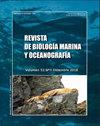海洋学条件和海洋哺乳动物:确定墨西哥中太平洋沿海地区的潜在关系
IF 0.5
4区 生物学
Q4 MARINE & FRESHWATER BIOLOGY
引用次数: 5
摘要
2011年,西班牙研究了可能影响墨西哥中太平洋海岸海洋哺乳动物丰富度和分布的海洋条件。通过两个研究平台对海洋哺乳动物进行了观察。每月对6个站进行取样,在100米范围内进行CTD,并采集水样以测定无机营养物质;另外15个监测站仅在冬季在更大的区域取样。利用卫星图像(MODIS-AQUA L2)获得海表温度(TSM)和叶绿素(Chl-a)值;以及高程数据,以确定该地区的动态中尺度结构。冬季-春季盐度高(34.6),硝酸盐和亚硝酸盐低(~3-4µM),硅酸盐低(5-7µM),叶绿素低(~10 mg M -3);此外,气温较低(~ 23.5°C),海岸附近存在气旋环流。与此同时,该地区海洋哺乳动物的丰富度较高(视空间尺度而定,为5至9种)。优势种为新大翅目(0.092 km-1),分布于浅水沿海地区。在夏季和秋季,盐度(32.8)和Chl-a (0.1 mg m-3)值较低。本研究的目的是评估海洋哺乳动物(3种)的丰富度,以确定海洋哺乳动物(3种)中磷酸盐的高可用性(2.5µM)、反气旋旋转和高温(~31°C)的存在。以Stenella attenuata为优势种(0.036 km-1),其个体分布在哈利斯科和科利马海岸附近(0-3mn),无机营养物质可用性高。主成分分析表明,水深测量(99.6%)是解释数据差异的主要参数,因此有可能调节海洋哺乳动物的生态方面。2011年对墨西哥中太平洋(MCP)沿海地区可能影响海洋哺乳动物物种丰富度和分布的海洋条件进行了调查。= =地理= =根据美国人口普查,该地区的总面积为,其中土地和(0.964平方公里)水。在6个监测站每月采集水样以测定有机营养物质,另外15个监测站仅在冬季在较大的区域采集水样。利用MODIS-AQUA L2卫星图像获取海表温度(SST)和叶绿素a (Chl-a)值,并利用高程数据确定该区域的中尺度动态结构。检测到高盐度值(34.6)、低硝酸盐和亚硝酸盐浓度(~3-4µM)、硅酸盐(5-7µM)、Chl-a (~10 mg M -3)和低SST(~23.5°C),以及在寒春期间海岸附近存在气旋旋流。这与该地区海洋哺乳动物物种丰富度高(根据空间尺度从5到9个物种)相一致。= =地理= =根据美国人口普查,这个县的总面积为,其中土地和(1.092平方公里)水。在夏秋两季检测到低盐度(32.8)和Chl-a值(0.1 mg m-3)。此外,还发现了高磷酸盐可用性(2.5µM)、高SST(~31°C)和低物种丰富度(3种)。优势种为Stenella attenuata(0.036目击km-1);这些个体分布在哈利斯科-克里马海岸附近(0-3 nm)的浅水水域,具有高无有机营养可用性。主要成分分析表明,水深(99.6%)是解释数据方差的主要参数;= =地理= =根据美国人口普查,该地区的总面积为,其中土地和(2.641平方公里)水。本文章由计算机程序翻译,如有差异,请以英文原文为准。
Oceanographic conditions and marine mammals: identifying a potential relationship in the coastal region of the Mexican Central Pacific
espanolSe investigaron las condiciones oceanograficas que podrian influir en la riqueza y distribucion de mamiferos marinos en costas del Pacifico Central Mexicano durante el 2011. Las observaciones de mamiferos marinos se realizaron desde dos plataformas de investigacion. Se muestrearon mensualmente 6 estaciones, donde se realizaron lances de CTD hasta 100 m y se tomaron muestras de agua para determinacion de nutrientes inorganicos; y otras 15 estaciones fueron muestreadas solamente durante invierno en una region mas amplia. Se utilizaron imagenes de satelite (MODIS-AQUA L2) para obtener valores de temperatura superficial del mar (TSM) y clorofila (Chl-a); y datos de altimetria para identificar estructuras dinamicas de mesoescala en la region. Durante invierno-primavera se encontraron valores altos de salinidad (34,6), valores bajos de nitratos y nitritos (~3-4 µM), silicatos (5-7 µM) y clorofila (~10 mg m-3); como tambien valores bajos de temperatura (~23,5°C) y la presencia de giros ciclonicos cerca de la costa. Esto coincidio con la riqueza mayor (de 5 a 9 especies dependiendo la escala espacial) de mamiferos marinos en la zona. La especie dominante fue Megaptera novaeangliae (0,092 avistamientos km-1), la cual se distribuyo hacia zonas costeras en aguas someras. Durante verano-otono se registraron valores bajos de salinidad (32,8) y Chl-a (0,1 mg m-3). Se detecto una disponibilidad alta de fosfatos (2,5 µM), la presencia de giros anticiclonicos y temperaturas altas (~31°C), coincidiendo con la riqueza mas baja (3 especies) de mamiferos marinos. Stenella attenuata fue la especie dominante (0,036 avistamientos km-1), cuyos individuos fueron encontrados distribuidos cerca de las costas de Jalisco y Colima (0-3mn), en aguas someras con una disponibilidad alta de nutrientes inorganicos. El analisis de componentes principales mostro que la batimetria (99.6%) fue el principal parametro que explica la varianza de los datos, por lo que podria potencialmente modular aspectos ecologicos de los mamiferos marinos. EnglishThe oceanographic conditions that could influence richness and distribution of marine mammal species in the coastal area of the Mexican Central Pacific (MCP) were investigated throughout 2011. Marine mammals observations were obtained from two research platforms. CTD casts were deployed down to 100 m, water samples were taken monthly at six stations for determination of organic nutrients, and another 15 stations were sampled over a wider area only during the winter. Satellite images from MODIS-AQUA L2 were used to obtain sea surface temperature (SST) and chlorophyll-a (Chl-a) values, likewise altimetry data to identify mesoscale dynamic structures in the region. High salinity values (34.6), low concentrations of nitrates and nitrites (~3-4 µM), silicates (5-7 µM), Chl-a (~10 mg m-3), and low SST (~23.5°C) were detected, as well as the presence of cyclonic gyres near the coast during the winter-spring period. This coincided with high marine mammal species richness in the area (from 5 to 9 species depending on spatial scale). The dominant species was Megaptera novaeangliae (0.092 sightings km-1), which was distributed close to the coast in shallow waters. Low salinity (32.8) and Chl-a values (0.1 mg m-3) were detected during the summer-fall period. High phosphate availability (2.5 µM), presence of anticyclonic gyres, and high SST (~31°C) were also found, coinciding with low species richness (3 species). The dominant species was Stenella attenuata (0.036 sightings km-1); those individuals were found distributed near the Jalisco-Colima coast (0-3 nm) in shallow waters with high inorganic nutrient availability. The principal components analysis showed that bathymetry (99.6%) was the main parameter explaining data variance; this parameter could therefore potentially modulate ecological aspects of marine mammals.
求助全文
通过发布文献求助,成功后即可免费获取论文全文。
去求助
来源期刊
CiteScore
0.70
自引率
0.00%
发文量
41
审稿时长
12 months
期刊介绍:
Publicar desde una perspectiva científica, artículos originales, decididos por un proceso de revisión por pares, invitando a expertos de reconocido prestigio en el área. Los trabajos publicados se caracterizarán por su solidez teórica-metodológica, actualidad y relevancia para las ciencias marinas.
Se reciben trabajos inéditos derivados de la investigación científica realizada en ambientes marinos y estuarios, en formato de Revisión, Artículos, Notas Científicas, y Obituarios en las siguientes disciplinas::
Biología-Ecología marina
Oceanografía física, química y biológica
Contaminación marina
Geología marina
Sistemática, Faunística y Biogeografía Marina
Manejo Costero
Acuicultura marina
Pesquería marina.

 求助内容:
求助内容: 应助结果提醒方式:
应助结果提醒方式:


